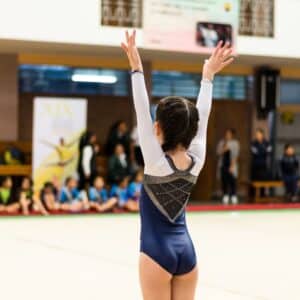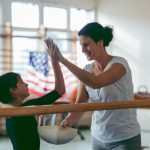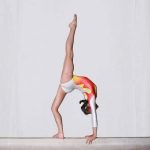
Have you ever wondered why a gymnastics salute is included at the beginning and end of routines? This article explores the origins and significance of the gymnastics salute, from its historical roots to its importance today.
Read on to discover the meaning behind this iconic gesture and how to perform the perfect salute!
What is a salute in gymnastics?
In gymnastics, a salute is a traditional gesture performed by athletes before and after their routines. It involves raising one arm or both arms above the head, with the hand(s) in a flat or fist position. The salute is a way for gymnasts to show respect and gratitude to the judges and the audience.
Why do gymnasts salute?
- Respect and Gratitude
Gymnasts salute to express respect and gratitude to the judges and audience. This gesture acknowledges the judges’ role in the competition and thanks the audience for their support and attention.
- Preparation
The salute also serves as a way for gymnasts to prepare themselves mentally and physically for their routines. It is a moment of focus and concentration, during which they can block out distractions and center themselves.
- Symbol of Readiness
Another reason gymnasts salute is that it is a symbol of readiness. Saluting signals readiness to the judges and audience. By raising their arms, gymnasts show they are prepared to start their performance.
- Tradition
Saluting is a longstanding tradition in gymnastics, connecting athletes to the history of the sport. By saluting, gymnasts honor this history and show respect for the athletes who came before. By saluting, gymnasts are participating in a ritual that is both meaningful and symbolic.
How to perform the perfect gymnastics salute
Though a small part of the routine, a confident salute with a smile creates a strong first impression with the judges.
Traditionally female gymnasts lift both arms whereas male gymnasts only salute with one. However, in modern gymnastics, many male gymnasts will also lift both arms as well.
To perform a salute that will impress the judges:
- Lift your chin
- Extend your arms fully, including your fingertips
- Step forward as you present
- Smile and make eye contact with the judges
- Salute with confidence, masking any nerves to show focus and preparation.

Where should a gymnast salute from?
There is some variation in whereabouts gymnasts salute at the start of a floor exercise. Some gymnasts will salute from the side of the floor and then walk to their starting position ready to begin the routine. Other gymnasts will walk onto the floor first and salute from their starting position.
There is no deduction either way for any meet that I am aware of so the choice is one made by the coach or gymnast.
For other events such as Vault, Uneven Bars or Beam the salute is much more straightforward as the gymnast will salute at the point where they will begin the exercise.
What if a gymnast forgets to salute?
In many competitions, forgetting to salute results in a deduction that can range from 0.1 to 0.3 points which doesn’t sound like much but if there are multiple judges and each one takes this amount it will add up to a significant amount.
At lower levels, judges may use their discretion and not impose the deduction.
Younger gymnasts are often nervous when they compete and it can mean they forget to salute because they are concentrating so hard on the routine! To help young gymnasts remember, practicing their routines in a mock competition with another coach acting as judge can be beneficial. This practice builds resilience and establishes cues that make them less likely to forget in a real competition.
The added pressure in a ‘mock’ competition can help gymnasts build resilience and develop cues that they can use in the real thing, therefore, reducing the chance they will forget to salute!
Conclusion
The gymnastics salute is an essential part of gymnastics culture. It expresses respect and gratitude, helps gymnasts prepare mentally, and signals readiness to perform. Rooted in tradition, the salute also connects today’s gymnasts to the sport’s rich history and values.
- How to Do a Back Handspring: Complete Step-by-Step GuideLearning how to do a back handspring is an exciting milestone for any gymnast. It builds confidence, agility, and forms the foundation for advanced tumbling… Read more: How to Do a Back Handspring: Complete Step-by-Step Guide
- How To Get Over a Mental Block In Gymnastics: A Complete GuideGymnastics is a sport that requires not only physical strength and skill but also mental strength. When a gymnast feels like they cannot attempt a… Read more: How To Get Over a Mental Block In Gymnastics: A Complete Guide
- The Best Leotard for Girls in 2025: What to Look ForFinding an ideal leotard for girls isn’t just about picking a dazzling design that sparkles (although it does help!). The leotard has to fit perfectly,… Read more: The Best Leotard for Girls in 2025: What to Look For
- The Best Gymnastics Shorts (Our Top Picks)The best gymnastics shorts are designed to be worn over the top of a leotard providing additional coverage around the upper legs, whilst allowing gymnasts… Read more: The Best Gymnastics Shorts (Our Top Picks)
- Decathlon Leotards – Are They Any Good?If you’re in the market for a new leotard, you may be wondering if Decathlon leotards are any good considering the low cost of their… Read more: Decathlon Leotards – Are They Any Good?
- A Complete Guide to Gymnastics Hand RipsAre you tired of dealing with painful gymnastics rips on your hands from training? Look no further – this article offers a comprehensive approach to… Read more: A Complete Guide to Gymnastics Hand Rips






